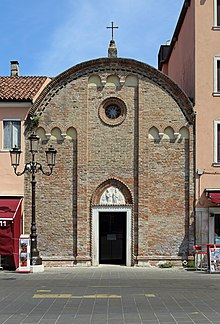Chiesa dei Santi Apostoli Pietro e Paolo, Chioggia
| Chiesa dei Santi Apostoli Pietro e Paolo | |
|---|---|
 The façade of the Church of the Holy Apostles Peter and Paul | |
| Religion | |
| Affiliation | Catholic |
| Province | Venice |
| Region | Veneto |
| Patron | Saint Peter, Saint Paul |
| Location | |
| Location | Chioggia, Venice, Italy |
| State | Italy |
| Territory | Chioggia |
| Geographic coordinates | 45°13′02″N 12°16′41″E / 45.217131°N 12.277961°E |
| Architecture | |
| Style | Gothic |
| Founder | Pietro Mazzagallo |
| Groundbreaking | 1431-1432 |
The Chiesa dei Santi Apostoli Pietro e Paolo, ("Church of the Holy Apostles Peter and Paul") also called San Pieretto by the local population of Chioggia due to its small size, is located in Campo del Duomo on the east side, is a Catholic church located in Chioggia, in the province of Venice, Veneto, Italy.[1]
History
[edit]The construction of this building was commissioned by Pietro Mazzagallo in his will, dating back to 1386 which is partly engraved on the entrance architrave, where it was also requested that mass be celebrated for the deceased and his relatives every day. It was completed between 1431 and 1432.
Between 1525 and 1528 the “Confraternita dei Battuti” of S.S Trinità found a temporary seat here, then the Confraternita moved to the Church of the Santissima Trinità at the Palazzo Pretorio.
Between the 1600s and 1700s it first became a singing school and then a temporary seat for the priests belonging to the oratory of S. Filippo Neri, until the completion of their church in Riva Vena.
After Republic of Venice fall in 1797, the little church was confiscated by the occupying forces, (French before and then Austrian), that converted it in a gunnera school, they placed inside a cannon on a chariot and also used it as a stable for horses. To do this, the entrance was enlarged and two windows were built on the façade.
At the beginning of the 1900s the church was bought by the Municipality of Chioggia, specifically by the Military Engineers, who restored the façade in 1921 thanks to previous studies by the local historian Aristide Naccari.
In 1941, after an exchange with the Church of San Nicolò (currently it is an Auditorium) which passed to the Municipality, San Pieretto became the property of the Cathedral Chapter.
After the last restoration (between 2011 and 2013), Bishop Adriano Tessarollo decided to dedicate this chapel to the adoration of the Crucifix. [2] [3]
Description
[edit]This section is empty. You can help by adding to it. (May 2023) |
Outside
[edit]The church shows only the façade and the back, because the side walls to the north and south are covered by houses built after the construction of the Church.
The façade with a semicircular crown is marked by three vertical bands closed like a hat by three pointed arches, with a small rose window in the center. The entrance portal in Carrara marble, (engraved with the origin of the monument and the coats of arms of the Mazzagallo family and the town of Chioggia) is surmounted by the bas-relief of Saints Peter and Paul.
Inside
[edit]The interior of the rectangular plan church is 7 meters wide, 15 long, reaching 12 meters in height on the semicircular dome. The large arch that divides the choir part from the rest of the church rests on marble capitals decorated with leaves. The altar consists of a medieval puteal (well) previously kept in the Seminary, surmounted by a glass altar.
The 17th century Carrara marble tabernacle (located on the right wall of the choir) is adorned with cherubs and instruments of the passion in relief over frescoed marble. A 17th century crucifix hangs from the ceiling (3.50 x 2.30 m). [4] [5] [6]
References
[edit]- ^ Marangon, Giuliano. Chiese storiche di Chioggia 2011, pg. 43.
- ^ MARANGON, Giuliano. Chiesa dei santi apostoli Pietro e Paolo 1431 2013, pg. 29.
- ^ Marangon, Giuliano. Chiese storiche di Chioggia 2011, pg. 44.
- ^ Marangon, Giuliano. Chiese storiche di Chioggia 2011, pg. 45.
- ^ MARANGON, Giuliano. Chiesa dei santi apostoli Pietro e Paolo 1431 2013, pg. 35.
- ^ Renzo,Ravagnan. Chioggia, Sottomarina, Isolaverde e dintorni... 2016, pg. 98.
